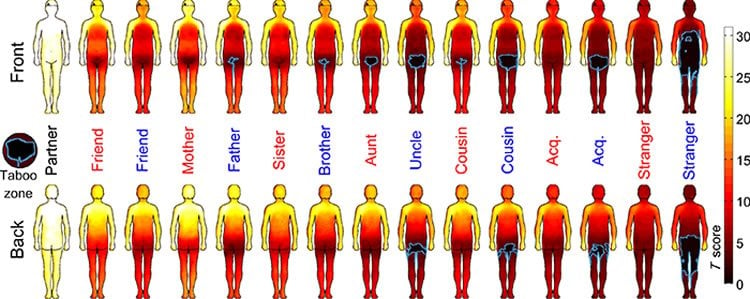Bodily maps of touch are consistent across a wide range of European cultures.
The recent study conducted by Aalto University and the University of Oxford shows that the human body has a precisely defined touch maps that are tightly linked to social touch that is allowed in different kinds of human relationships.
The closer the person in social relationship, the larger the body area this person is allowed to touch. The bodily maps of touch were similar in all five cultures studied. Social touching thus seems to be a biologically determined and evolutionarily developed way to form social relationships. The results were recently published in Proceedings of the National Academy.
– Our findings indicate that touching is an important means of maintaining social relationships. The bodily maps of touch were closely associated with the pleasure caused by touching. The greater the pleasure caused by touching a specific area of the body, the more selectively we allow others to touch it, says researcher Juulia Suvilehto from Aalto University.
– The results emphasise the importance of non-verbal communication in social relationships. Social relationships are important for well-being throughout peoples’ life, and their lack poses a significant psychological and somatic health risk. Our results help to understand the mechanisms related to maintaining social relationships and the associated disorders, says Professor Lauri Nummenmaa.

The study was conducted in the form of an online questionnaire in which more than 1 300 people from Finland, England, Italy, France and Russia participated. The study commenced with the mapping of the participants’ social network. The participants were then asked to colour the areas of human body shown on a computer where different members of the social network could touch them.
Funding: The research was funded by the European Research Council (ERC), the Academy of Finland and the Emil Aaltonen Foundation.
Source: Juulia Suvilehto – Aalto University
Image Source: The image is credited to the researchers/Aalto University
Original Research: Full open access research for “Topography of social touching depends on emotional bonds between humans” by Juulia T. Suvilehto, Enrico Glerean, Robin I. M. Dunbar, Riitta Hari, and Lauri Nummenmaa in PNAS. Published online October 26 2015 doi:10.1073/pnas.1519231112
Abstract
Topography of social touching depends on emotional bonds between humans
Nonhuman primates use social touch for maintenance and reinforcement of social structures, yet the role of social touch in human bonding in different reproductive, affiliative, and kinship-based relationships remains unresolved. Here we reveal quantified, relationship-specific maps of bodily regions where social touch is allowed in a large cross-cultural dataset (N = 1,368 from Finland, France, Italy, Russia, and the United Kingdom). Participants were shown front and back silhouettes of human bodies with a word denoting one member of their social network. They were asked to color, on separate trials, the bodily regions where each individual in their social network would be allowed to touch them. Across all tested cultures, the total bodily area where touching was allowed was linearly dependent (mean r2 = 0.54) on the emotional bond with the toucher, but independent of when that person was last encountered. Close acquaintances and family members were touched for more reasons than less familiar individuals. The bodily area others are allowed to touch thus represented, in a parametric fashion, the strength of the relationship-specific emotional bond. We propose that the spatial patterns of human social touch reflect an important mechanism supporting the maintenance of social bonds.
“Topography of social touching depends on emotional bonds between humans” by Juulia T. Suvilehto, Enrico Glerean, Robin I. M. Dunbar, Riitta Hari, and Lauri Nummenmaa in PNAS. Published online October 26 2015 doi:10.1073/pnas.1519231112







